Sold Ceramics
Sold Red & Gold / Rouge-de-Fer 1690-1730
Flowers, Animals and Long Elizas
Page 1
This type of porcelain with decorations painted in iron-red, gold and some black enamel, is traditionally called melk en bloed, (which literarily translates as milk and blood). Interestingly, in The Netherlands in the 18th century the name was also applied to a specific type of imported Indian chintz, with predominantly red decorations on a light ground. The composition and iconography usely conform to the normal export assortment of blue-and-white Kangxi porcelain of c.1700. The dating of early 18th century is confirmed by the existence of some Red & Gold objects in the collection of August the Strong (1670-1733). Apparently, this type of porcelain was popular mainly among the Dutch and the very few pieces that can be found elsewhere in Europe usually come from The Netherlands. (Lunsingh Scheurleer 1989), (Jörg 2002/2)
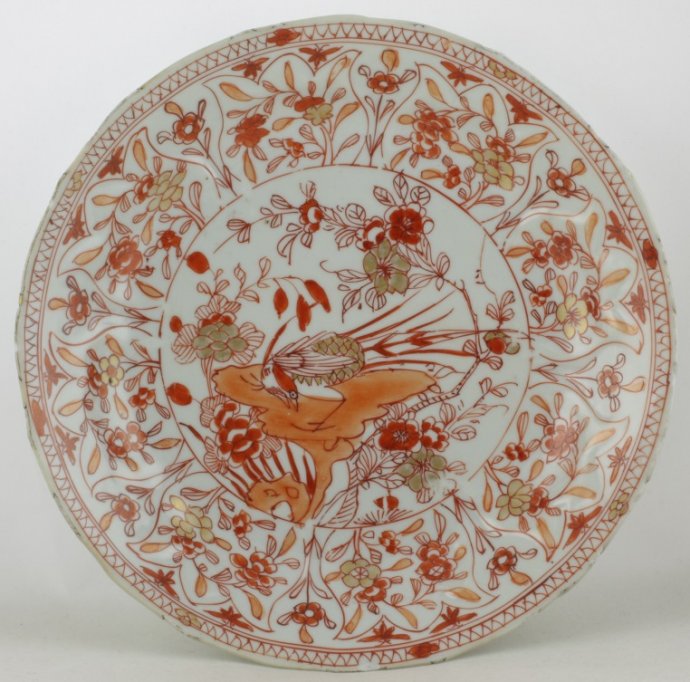
Sold Ceramics - Sold Red & Gold / Rouge-de-Fer 1690-1730 - Flowers, Animals and Long Elizas - Page 1
Object 2011946
Dish
China
c.1700
Height 34 mm (1.34 inch), diameter of rim 219 mm (8.62 inch), diameter of footring 117 mm (4.61 inch), weight 325 grams (11.46 ounce (oz.))
Published:
- Melk en Bloed. Erlesenes Porzellan aus dem Reich der Mitte, (D. Suebsman, Norden 2018), p.52, cat. 12.
- Melk en Bloed. Exquisite porcelain from the Middle Kingdom, (D. Suebsman, Norden 2019), p.52, cat. 12.
Dish on a footring, the spreading sides modeled with pomegranate-shaped panels in low relief and a scalloped rim. Decorated in 'Red & Gold' / 'Rouge-de-fer' with iron-red and gold on the glaze with a pheasant on a taihu rock flanked by flowering plants. On the sides large panels filled with flowering plants in-between these panels single flowering plants. Around the rim a pointed leaves pattern border with flower heads. The reverse is undecorated.
The border design with the modelled pomegranate-shape panels must have been popular at the time as it is known with various central designs in 'Red & Gold' / 'Rouge-de-fer' as well as in underglaze blue (see:
Sold Ceramics - Sold Blue and White Kangxi Period 1660-1722 - Dishes - Page 2 - Object 2011569) and a mixture of underglaze blue and 'Red & Gold' / 'Rouge-de-fer' designs. In the cargo of the Ca Mau shipwreck, c.1725 a series of eight dishes with identically decorated border designs in underglaze blue were found. (Amsterdam 2007, p.44, lot 89)
For other identically shaped dishes with a similar border design and other central designs, please see:
- Chinese export porcelain. Chine de Commande, (D.F. Lunsingh Scheurleer, London, 1974), English translation of the Dutch edition, Hilversum 1966, cat. 319.
- Jan Menze van Diepen Stichting. Selectie uit de collectie Oosterse keramiek. (Jan Menze van Diepen Foundation. A Selection from the Collection of Oriental Ceramics), (C.J.A. Jörg, Slochteren, 2002), p.118, cat. 80.
- Kostbaar Goed van Grote Pracht. Chinees en Japans exportporselein uit de 17e en 18e eeuw, (Mr. L.C.A.M. Schölvinck, Zwolle 2010), p.43.
- Have a Cup of Tea. Chinese Porcelain and Tea in North-West Germany, (Exhibition catalogue, Isensee Verlag, Oldenburg, 2015), p.82, cat. 42 / Made in China, Porzellan und Teekultur im Nordwesten, Exhibition catalogue, Isensee Verlag, Oldenburg, 2015), p.116, cat. 42.
- Porzellanschätze der Kangxi-Zeit / Porcelain Treasures of the Kangxi Period, (Exhibition catalogue, Deutsch-Chinesische Verlagsanstalt, Düsseldorf / Beijing 2015), pp.216-219, cat 123.1-123.5.
The pheasant on a rock is a very popular motif on export porcelain and frequently appears on enamelled and underglaze blue Kangxi wares. In Chinese bureaucratic hierarchy officials of the second grade had a gold pheasant embroidered on their court robes, those of the fifth grade a silver pheasant. The bird was represented as standing on a rock, looking towards the sun, the imperial symbol of authority. (Williams 1976, pp.322-323), (Jörg & Van Campen 1997, p.157)
Chinese Mandarin rank badge of a silver Pheasant, fifth grade civil servant, c.1850, Qing dynasty (1644-1911) © 2014 LAPADA, the association of art & antique dealers.
For other objects decorated with a pheasant on rockwork, please see:
- Chinese Ceramics in the Collection of the Rijksmuseum, Amsterdam. The Ming and Qing Dynasties, (C.J.A. Jörg in collaboration with J. van Campen, Philip Wilson Publishers Limited, London, 1997), p.157, cat. 171.
Condition: Various glaze rough spots, two tiny chips and a short glaze hairline to the rim (only visible on the reverse).
References:
Lunsingh Scheurleer 1974, cat. 318 & 319
Jörg & Van Campen 1997, cat. 171
Düsseldorf 2015, cat. 123.1-123.5
Price: Sold.
More pictures of object 2011945, another identically shaped, sized and decorated, sold dish >>
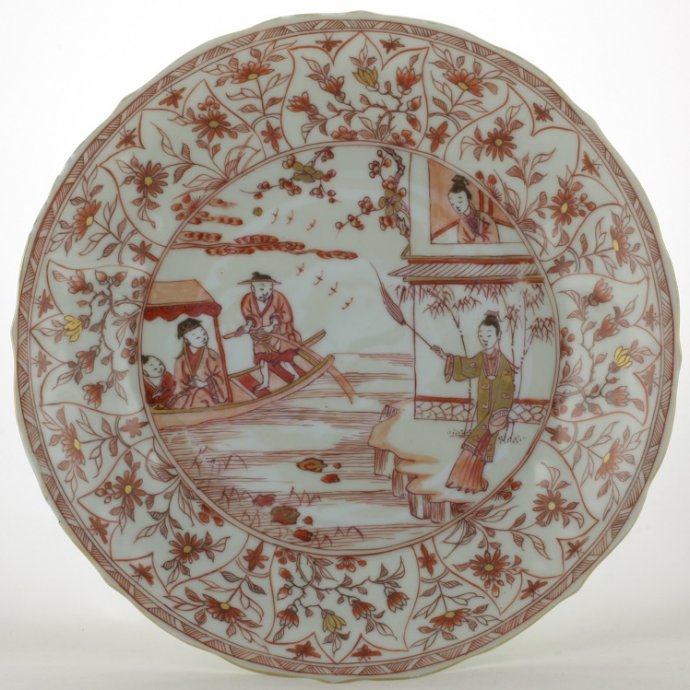
Sold Ceramics - Sold Red & Gold / Rouge-de-Fer 1690-1730 - Flowers, Animals and Long Elizas - Page 1
Object 2011425
Dish
China
c.1700
Height 37 mm (1.46 inch), diameter of rim 225 mm (8.85 inch), diameter of footring 126 mm (4.96 inch), weight 325 grams (11.46 ounce (oz.))
Dish on a footring, the spreading sides modelled with pomegranate-shaped panels in low relief, scalloped rim. Decorated in 'Red & Gold' / 'Rouge-de-fer' with iron-red, black enamel and gold on the glaze with a river scene with three people in a boat, one in a house and on the shore waving a whisk at the people in the boat. On the sides large panels filled with flowering plants in-between these panels single flowering plants. Around the rim a trellis pattern border with half flower heads. On the reverse two flower sprays.
The Lady with the Red Whisk
The popular Chinese drama ' The Lady with the Red Whisk' (Hongfu nü), set in the late Sui dynasty (584-618), tells the story of the courtesan Zhang Chuchen, known as Lady Hongfu, who is the mistress of the minister Yang Su (D.606), but who simultaneously starts a love affair with the young scholar Li Jing (571-649). Eventually the lovers elope and later help to topple the Sui dynasty. Li Jing is promoted to general and goes on to co-found the Tang dynasty. The story was first published in the Tang dynasty as part of the 'Biography of the Dragon-bearded man' (Qui ran ke Zhuan) by Du Guangting (850-933) and was the beginning of a series of adaptations. (Suebsman 2019, p.34)
On this dish we see Lady Hongfu escaping in the night in a boat, disguised as a man. A friend of hers, another courtesan, waves goodbye to her with the duster that Hongfu has left behind. Scenes from Hongfu's tory can be found mostly on Kangxi-period blue-and-white porcelain. On Melk en Bloed (milk and blood) only two scenes are known. (Suebsman 2019, p.34)
For an identically, sized and decorated dish, please see:
- "Porseleinzaal van Age Looxma Ypeij in ere hersteld", D. Pohle in: Keramika, Jaargang 18, Nummer 4, Winter 2006, p.16, cat. 2.
- Melk en Bloed. Exquisite porcelain from the Middle Kingdom, (D. Suebsman, Norden 2019), pp.34-35, cat. 5.
For similarly decorated dishes, please see:
- Chinese export porcelain. Chine de Commande, (D.F. Lunsingh Scheurleer, London, 1974), English translation of the Dutch edition, Hilversum 1966, cat. 318 & 319.
- De Chinese Porseleinkast, (D.F. Lunsingh Scheurleer in Mededelingenblad Nederlandse Vereniging van Vrienden van de Ceramiek, vol. 52, 1968), pp. 32-33, cat. 114.
- Oosterse keramiek uit Groninger kollekties, exhibition catalogue Groninger Museum, (C.J.A. Jörg, Martinipers/Wolters-Noordhoff, Groningen 1982), p.56, cat. 78.
- Chine de Commande, (D.F. Lunsingh Scheurleer, Lochem 1989), p.126, cat. 105.
- Jan Menze van Diepen Stichting. Selectie uit de collectie Oosterse keramiek. (Jan Menze van Diepen Foundation. A Selection from the Collection of Oriental Ceramics), (C.J.A. Jörg, Slochteren, 2002), p.118, cat. 80.
Condition: A few glaze rough spots and a hairline to the rim. Some shallow frits and chips to the footring.
References;
Lunsingh Scheurleer 1968, cat. 114
Lunsingh Scheurleer 1974, cat. 318 & 319
Lunsingh Scheurleer 1989, cat. 105
Price: Sold.
More pictures of object 2011434, another identically, shaped, sized and decorated, sold dish >>
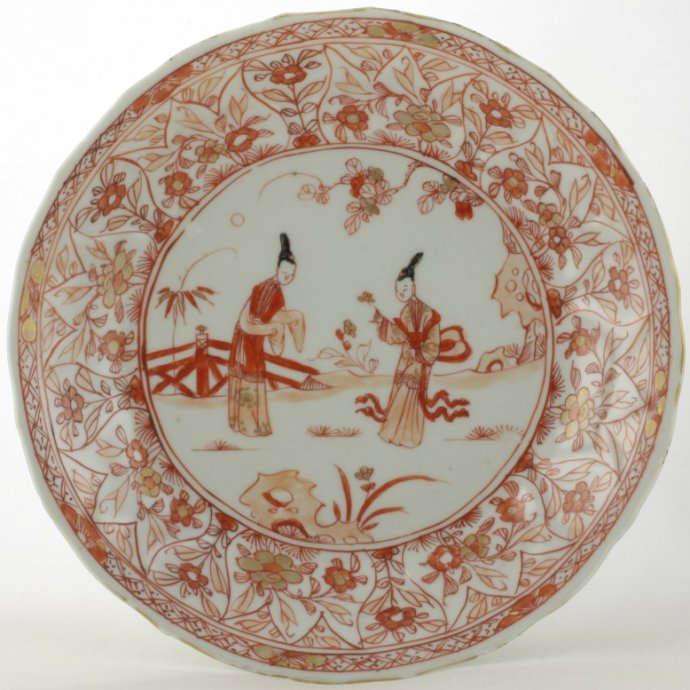
Sold Ceramics - Sold Red & Gold / Rouge-de-Fer 1690-1730 - Flowers, Animals and Long Elizas - Page 1
Object 2011453
Dish
China
c.1700
Height 30 mm (1.18 inch), diameter of rim 220 mm (8.66 inch), diameter of footring 121 mm (4.76 inch)
Dish on a footring, the spreading sides modelled with pomegranate-shaped panels in low relief, scalloped rim and a glazed base. Decorated in 'Red & Gold' / 'Rouge-de-fer' with iron-red, black enamel and gold on the glaze with two ladies in a garden landscape near a fence with flowering plants, trees, the sun and pierced rockwork. On the sides large panels filled with flowering plants in-between these panels single flowering plants. Around the rim a trellis pattern border with half flower heads. On the reverse two flower sprays.
Romance of the Western Chamber
The love story' Romance of the Western Chamber' (Xixiang ji) ranks among the most famous literary works of China. Its importance for young people can be compared to that of Shakespeare's 'Romeo and Juliet' in the West. 'Romance of the Western Chamber' was written by Wang Shifu (1260-1336). There already existed a short story in the Tang dynasty titled 'Biography of Yingying' (Yingying Zhuan) by Yuan Zhen (779-831), but Wang Shifu adapted it by adding details and giving it a happy rather than a sad ending. It tells the story of a forbidden love affair between the civil servant Zhang Sheng, who is gifted, but of a poor family background, and the pretty Cui Yingying, daughter of the Prime Minister. The two young people have their first encounter in a Buddhist temple, where Yingying and her mother have taken lodgings when accompanying the coffin of the recently deceased father back home. Suddenly, the temple is besieged by a local gang of outlaws, who demand the daughter to be handed over. Yingying's mother promises her daughter's hand in marriage to whoever saves the daughter from falling into the hands of the gang leader. However, when Zhang succeeds in doing so with the help of General Du, his childhood friend, she does not keep her promise. The young couple start a secret affair, supported by Hongniang ('Lady in Red'), Yingying's maid. When Yingying's mother discovers the affair, she consents to the marriage on the condition that Zhang passes the final examination for the highest position in the civil service of the capital, Zhang does so well, that he is granted a top position. (Suebsman 2019, p.43)
On this dish we see the two characters Yingying and Hongniang admiring flowers in the gardens of Pujiu Monastery. The student Zhang is about to see Yingying for the first time and fall in love with her. There also is an underglaze blue version of this motif. (Düsseldorf 2015, cat. 123.1 & Suebsman 2019, p.44)
For identically decorated dishes, please see:
- Jan Menze van Diepen Stichting. Selectie uit de collectie Oosterse keramiek. (Jan Menze van Diepen Foundation. A Selection from the Collection of Oriental Ceramics), (C.J.A. Jörg, Slochteren, 2002), p.118, cat. 80.
- Porzellanschätze der Kangxi-Zeit / Porcelain Treasures of the Kangxi Period, (Exhibition catalogue, Deutsch-Chinesische Verlagsanstalt, Düsseldorf / Beijing 2015), p.216, cat 123.1.
- The ceramic collection of the Musée de la Compagnie des Indes de Lorient, Fort de l'Aigle, Port-Louis, inv.nr. ML400 C250.
For an (almost) identically in underglaze blue decorated version of this dish, please see:
For similarly decorated dishes, please see:
- Chinese export porcelain. Chine de Commande, (D.F. Lunsingh Scheurleer, London, 1974), English translation of the Dutch edition, Hilversum 1966, cat. 318 & 319.
- De Chinese Porseleinkast, (D.F. Lunsingh Scheurleer in Mededelingenblad Nederlandse Vereniging van Vrienden van de Ceramiek, vol. 52, 1968), pp. 32-33, cat. 114.
- Oosterse keramiek uit Groninger kollekties, exhibition catalogue Groninger Museum, (C.J.A. Jörg, Martinipers/Wolters-Noordhoff, Groningen 1982), p.56, cat. 78.
- Chine de Commande, (D.F. Lunsingh Scheurleer, Lochem 1989), p.126, cat. 105.
- "Porseleinzaal van Age Looxma Ypeij in ere hersteld", D. Pohle in: Keramika, Jaargang 18, Nummer 4, Winter 2006, p.16, cat. 2.
Condition: A few glaze rough spots a fleabite and a frit to the rim. Some shallow frits and chips to the footring.
References:
Lunsingh Scheurleer 1968, cat. 114
Lunsingh Scheurleer 1974, cat. 318 & 319
Lunsingh Scheurleer 1989, cat. 105
Suebsman 2019, p.43 & cat. 11.1
musee.lorient.fr/, inv.nr. ML400 C250
Price: Sold.
More pictures of object 2011445, another identically shaped, sized and decorated, sold dish >>

Sold Ceramics - Sold Red & Gold / Rouge-de-Fer 1690-1730 - Flowers, Animals and Long Elizas - Page 1
Object 2011644
Bowl
China
1700-1720
Height 87 mm (3.43 inch), diameter of rim 191 mm (7.52 inch), diameter of footring 76 mm (2.99 inch), weight 471 grams (16.61 ounce (oz.))
Bowl on footring, straight underglaze brown-edged rim (jia mangkou). Decorated in 'Red & Gold' / 'Rouge-de-fer' with a light (pink-wash), iron-red and gold on the glaze with three groups of peony and chrysanthemum plants. Around the inside rim a border with four cartouches on a trellis pattern ground with a single flower head, filled with flower sprays. On the bottom a large peony flower spray.
Schölvinck states that objects decorated in 'Red & Gold' / 'Rouge-de-fer' were very much appreciated in the Netherlands, especially in the Northern province Groningen. (Schölvinck 2010, p.42)
Condition: A small restored chip and two very small restored fleabites to the rim.
References:
Price: Sold.
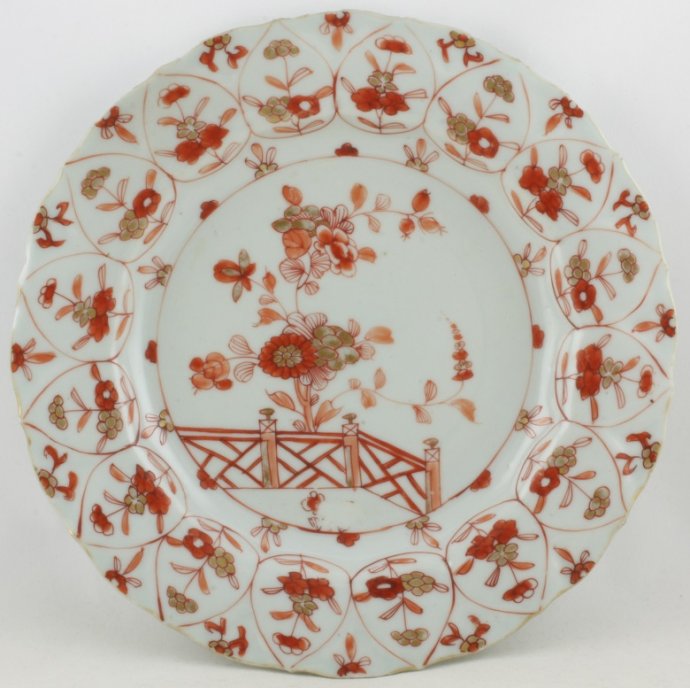
Sold Ceramics - Sold Red & Gold / Rouge-de-Fer 1690-1730 - Flowers, Animals and Long Elizas - Page 1
Object 2012213
Dish
China
c.1700
Height 27 mm (1.06 inch), diameter of rim 215 mm (8.46 inch), diameter of footring 107 mm (4.21 inch), weight 332 grams (11.17 ounce (oz.))
Dish on a footring with a moulded, lightly scalloped rim and egg-shaped panels in low relief. Decorated in 'Red & Gold' / 'Rouge-de-fer' with iron-red and gold on the glaze with a flowering, peony, chrysanthemum and lotus plants growing from behind a fence. On the sides sixteen panels each filled with flower sprays and separated with flower spray/head. On the reverse two flower sprays.
There is an identical dish in the former collection of King AUgustus the Strong in Dresden, Germany. (Suebsman 2019, cat. 14)
For an identically shaped, sized and decorated dish with a similar border design, please see:
The centre design combined with lightly scalloped rim and egg-shaped panels in low relief must have been very popular at the begin of the eighteenth century. Dishes with this shape, size and design decorated in Chinese Imari have derived from this earlier (Kangxi) example decorated in 'Red & Gold' / 'Rouge-de-fer' with iron-red and gold on the glaze.
Sold object 2010119, an identically, in Chinese Imari, decorated dish, (this dish is not included in this sale/offer).
Condition: Firing flaws to the base and inner footring, some glaze rough spots, a frit and a chip to the rim.
Reference:
Price: Sold.
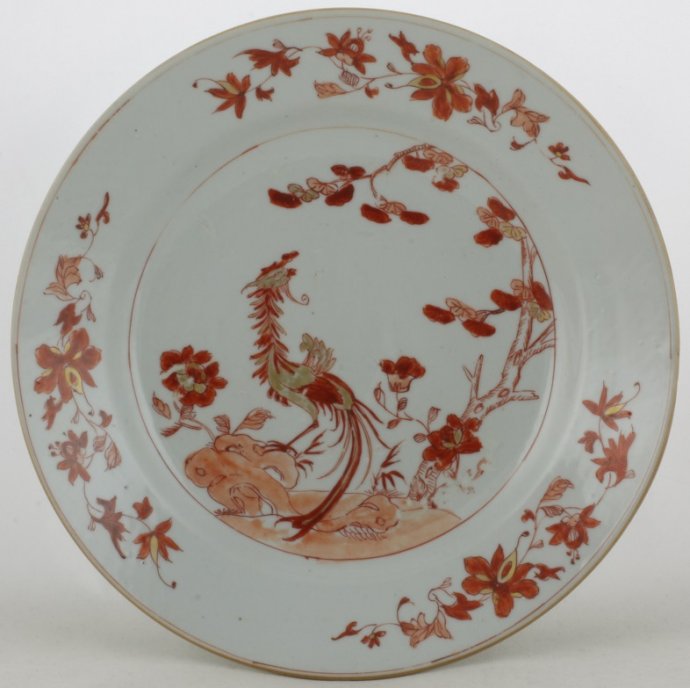
Sold Ceramics - Sold Red & Gold / Rouge-de-Fer 1690-1730 - Flowers, Animals and Long Elizas - Page 1
Object 2011450
Dish
China
1700-1720
Height 32 mm (1.26 inch), diameter of rim 206 mm (8.11 inch), diameter of footring 115 mm (4.53 inch), weight 279 grams (9.84 ounce (oz.))
Dish on footring, spreading flat, underglaze brown-edged rim (jia mangkou). Decorated in 'Red & Gold' / 'Rouge-de-fer' with iron-red and gold on the glaze with a feng-huang, perched on a taihu (garden) rock in a garden landscape with flowering peony plants and a tree. On the rim three flowering lily sprays. The reverse is undecorated.
The feng-huang, also called feng or (misleadingly) Chinese phoenix, is in Chinese mythology, an immortal bird whose rare appearance is said to be an omen foretelling harmony at the ascent to the throne of a new emperor. Like the qilin (a unicorn-like creature), the feng-huang is often considered to signify both male and female elements, a yin-yang harmony; its name is a combination of the words feng representing the male aspect and huang the female. (Wikipedia), (Britannica Online Encyclopaedia)
Condition: Firing flaws to the base and rim. A fleabite and frit to the reverse rim.
References;
Britannica Online Encyclopaedia
Price: Sold.
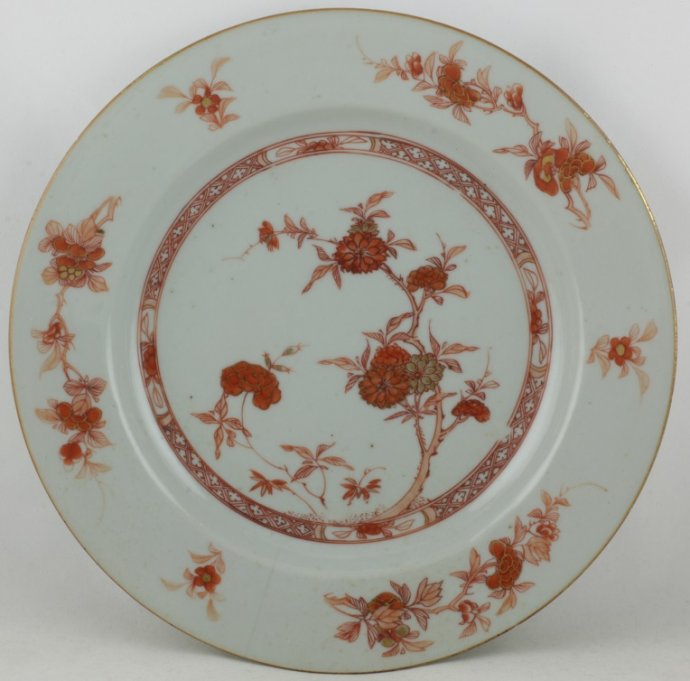
Sold Ceramics - Sold Red & Gold / Rouge-de-Fer 1690-1730 - Flowers, Animals and Long Elizas - Page 1
Object 2011558
Dish
China
1700-1720
Height 28 mm (1.10 inch), diameter of rim 222 mm (8.74 inch), diameter of footring 115 mm (4.53 inch), weight 275 grams (9.70 ounce (oz.))
Dish on footring, spreading flat, underglaze brown-edged rim (jia mangkou). Decorated in 'Red & Gold' / 'Rouge-de-fer' with iron-red and gold on the glaze with a flowering peony plant and a chrysanthemum tree in a diaper-pattern border with reserves filled with flower heads. On the rim three sprays. The reverse is undecorated.
Condition: A hairline, two chips and some fleabites and frits to the reverse rim.
References;
Price: Sold.

Sold Ceramics - Sold Red & Gold / Rouge-de-Fer 1690-1730 - Flowers, Animals and Long Elizas - Page 1
Object 2011380
Dish
China
1720-1730
Height 29 mm (1.14 inch), diameter of rim 225 mm (8.86 inch), diameter of footring 115 mm (4.53 inch), weight 367 grams (12.95 ounce (oz.))
Dish on footring, spreading flat, underglaze brown-edged rim (jia mangkou). Decorated in 'Red & Gold' / 'Rouge-de-fer' with iron-red and gold on the glaze with bamboo and flowering peony and chryanthemum sprays and fruiting Buddha's hand citron (Citrus medica) branches all tied together with a ribbon. On the rim an opened silk scroll with flower heads and leafy scrolls alternating with a tiled wall with overhanging flowering plants and leafy branches admidst clouds or mist. The reverse is undecorated.
The diamond shaped tiled wall on the rim with the overhanging flowering plants and leafy branches give a good dimension of depth. The decorator is, most likely, trying to display a wonderful garden scene (perhaps early in the morning). Clearly the design and hand drawing are master level and not something from a production line.
For an identically shaped, sized and decorated dish, please see:
Condition: Some firing flaws, some frits and filled frits and a filled chip to the reverse rim, a hairline to the rim.
References:
Price: Sold.

Sold Ceramics - Sold Red & Gold / Rouge-de-Fer 1690-1730 - Flowers, Animals and Long Elizas - Page 1
Object 2011545
Dish
China
1710-1720
Height 31 mm (1.22 inch), diameter of rim 211 mm (8.30 inch), diameter of footring 111 mm (4.37 inch), weight 272 grams (9.59 ounce (oz.))
Dish on footring, spreading flat, underglaze brown-edged rim (jia mangkou). Decorated in 'Red & Gold' / 'Rouge-de-fer' with iron-red and gold on the glaze with a moon lit scene of two insects in flight and two birds one in flight the other perched on the branch of a flowering tree growing from behind a low wall. The low wall is decorated with a river scape scene. On the left a flowering peony tree growing from behind a fence. The reverse is undecorated.
In the Netherlands this specific category of export porcelain from the Kangxi period, namely pieces that are decorated in overglaze iron-red and gold are traditionally called Melk en Bloed ('milk and blood') and much of it was bought and used in this country in past. In fact, recent research (as yet unpublished) has led to the thesis that this type of porcelain was probably specially made for the northern Dutch provinces of Groningen and Friesland. The reason for this might have been the contradicting combination of a normative Calvinistic restraint that approved of 'simple' and the subtle rich appearance of this red and gold porcelain that indicated luxury. (Suebsman 2019, p.10)
Condition: A firing flaw and three hairlines to the rim.
References:
Price: Sold.
More pictures of object 2012245, another identically shaped, sized and decorated, sold, dish >>
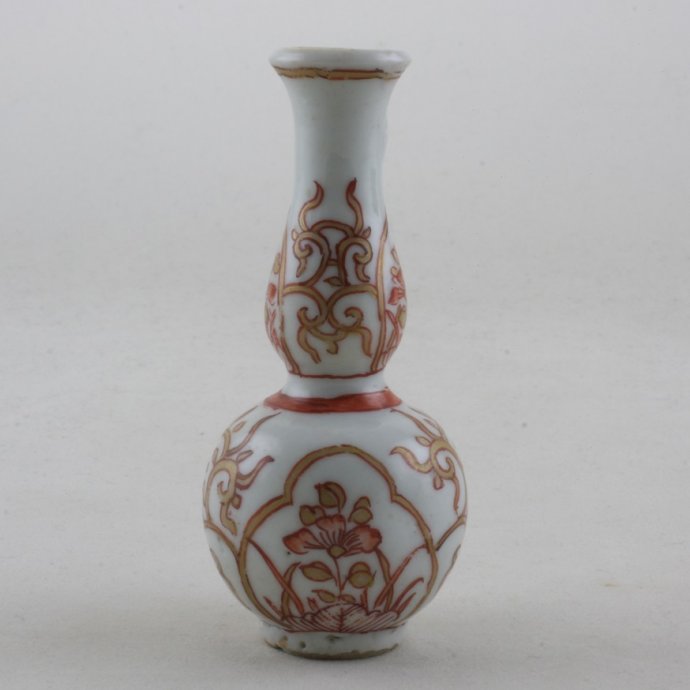
Sold Ceramics - Sold Red & Gold / Rouge-de-Fer 1690-1730 - Flowers, Animals and Long Elizas - Page 1
Object 2012613
Double-gourd vase
China
1700-1720
Height 83 mm (3.27 inch), diameter 39 mm (1.54 inch), diameter of mouthrim 17 mm (0.67 inch), diameter of foot 18 mm (0.71 inch), weight 48 grams (1.69 ounce (oz.))
A double-gourd miniature "doll's house" vase on a flat unglazed base. Decorated in 'Red & Gold' / 'Rouge-de-fer' with iron-red and gold on the glaze with two panels filled with a flowering plant and grasses alternating with foliage scrolls. On the shoulder an broad iron-red band, On the neck two panels filled with a flowering plant and grasses alternating with foliage scrolls. Round the mouthrim a single band in gold.
It was a popular pastime for the ladies of the Dutch patrician society to furnish doll's houses, whose various rooms reflected those of their own town palaces. Apart from the usual furniture, miniature versions of exotic luxury goods such as porcelain, fabrics, carpets and lacquer were obligatory. The doll's house of Petronella Oortman, now in the Rijksmuseum of Amsterdam, and that of Lita de Ranitz in the Historical Museum of the Hague are considered to be the most prominent examples. The Chinese had produced miniature ceramics for almost one thousand years for the decoration of birdcages, therefore it was no problem for them to supply the Dutch with doll's house porcelain. Miniature pieces were also displayed in ordinary porcelain rooms. (Suebsman 2019, pp.76-77, cat. 28)
Reference:
Condition: Some firing flaws and a very tiny shallow fleabite to the rim.
Price: Sold.

Sold Ceramics - Sold Red & Gold / Rouge-de-Fer 1690-1730 - Flowers, Animals and Long Elizas - Page 1
Object 2012413
A miniature 'doll's house' vase
China
c.1700-1720
Height 80 mm (3.15 inch), diameter 36 mm (1.42 inch), diameter of mouthrim 7 mm (0.28 inch), diameter of footring 23 mm (0.91 inch), weight 31 grams (1.09 ounce (oz.))
Miniature 'doll's house' vase on footring with an unglazed base. Decorated in 'Red & Gold' / 'Rouge-de-fer' with iron-red and gold on the glaze with a wide spread flowering tree.
It was a popular pastime for the ladies of the Dutch patrician society to furnish doll's houses, whose various rooms reflected those of their own town palaces. Apart from the usual furniture, miniature versions of exotic luxury goods such as porcelain, fabrics, carpets and lacquer were obligatory. The doll's house of Petronella Oortman, now in the Rijksmuseum of Amsterdam, and that of Lita de Ranitz in the Historical Museum of the Hague are considered to be the most prominent examples. The Chinese had produced miniature ceramics for almost one thousand years for the decoration of birdcages, therefore it was no problem for them to supply the Dutch with doll's house porcelain. Miniature pieces were also displayed in ordinary porcelain rooms. ( Suebsman 2019, pp.76-77, cat. 28)
The doll’s house of Petronella Oortman (1656-1716), c.1686 - c.1710, Rijksmuseum, Amsterdam, the Netherlands, inv.nr. BK-NM-1010. Two spittoons are standing beside the table and chairs. (Picture courtesy : judithsgarden.eu)
For an identically shaped, sized and decorated miniature doll's house vase, please see:
Condition: Perfect with a firing flaw to the unglazed base.
References:
Price: Sold.

Sold Ceramics - Sold Red & Gold / Rouge-de-Fer 1690-1730 - Flowers, Animals and Long Elizas - Page 1
Object 2011674
Dish
China
1720-1740
Height 25 mm (0.98 inch), diameter of rim 231 mm (9.09 inch), diameter of footring 125 mm (4.92 inch), weight 377 grams (13.30 ounce (oz.))
Dish on footring, flat underglaze brown-edged rim (jia mangkou). Decorated in 'Red & Gold' / 'Rouge-de-fer' with iron-red, silver (oxidised) and gold with a flowering peony and fruiting pomegranate spay, the sides are undecorated. Round the rim flowerheads with a cracked-ice motif in gold on an oxidised silver ground. The reverse is undecorated.
The Silvering technique appeared around 1700. When new (or polished), silver oxide brought another highly distinctive addition to the colour palette. It was used most frequently for armorials. Its tendency to tarnish and the difficulty of maintaining the thin layer of silver caused its use to wane by mid-century. (Sargent 2012, p.238)
The cracked-ice background was one of the new decorating methods in the Kangxi period: leaving certain decorative elements white on a blue background. Nowadays there is a preference for replacing the term 'cracked-ice' by 'erratic paths', after the paths of that name in Chinese gardens, as depicted on paintings and block printing from which this motif may derive. (Hartog 1990, p.149)
Condition: Some fleabites and a frit to the reverse rim.
References:
Price: Sold.
More pictures of object 2012084, another identically shaped, sized and decorated, sold, dish >>
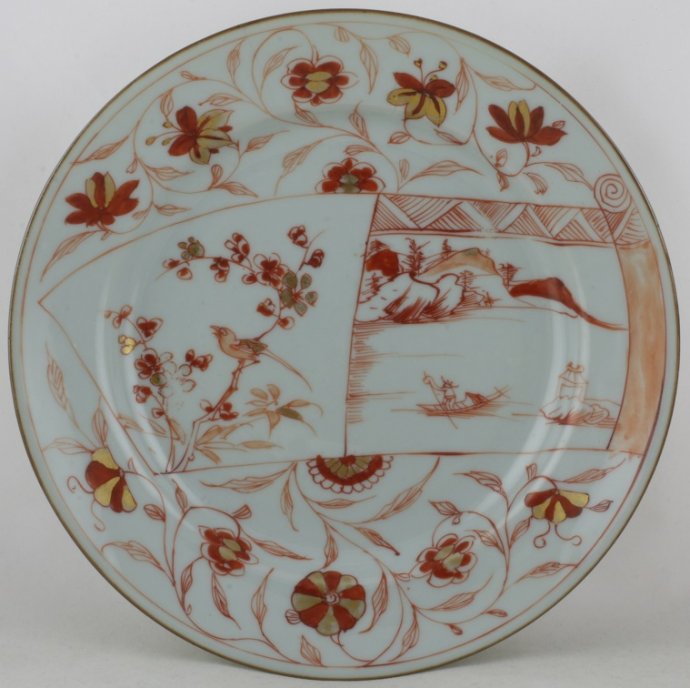
Sold Ceramics - Sold Red & Gold / Rouge-de-Fer 1690-1730 - Flowers, Animals and Long Elizas - Page 1
Object 2011487
Dish
China
c.1725
Height 24 mm (0.95 inch), diameter of rim 212 mm (8.35 inch), diameter of footring 117 mm (4.61 inch), weight 280 grams (9.88 ounce (oz.))
Dish on footring, flat underglaze brown-edged rim (jia mangkou). Decorated in 'Red & Gold' or 'Rouge de Fer' with iron-red and gold on the glaze with a fan shaped panel filled with a bird perched on the branch of a tree and a half-open scroll showing a river scape. The fan shaped panel and the half-open scroll are outlined by foliate and floral scrolls. The reverse is undecorated.
Condition: A restored frit with a connected hairline to the rim.
Reference:
Price: Sold.

Sold Ceramics - Sold Red & Gold / Rouge-de-Fer 1690-1730 - Flowers, Animals and Long Elizas - Page 1
Object 2011451
Dish
China
1735-1745
Height 22 mm (0.87 inch), diameter of rim 230 mm (9.06 inch), diameter of footring 116 mm (4.57 inch), weight 308 grams (10.86 ounce (oz.))
Dish on footring, spreading flat, underglaze brown-edged rim (jia mangkou). Decorated in 'Red & Gold' / 'Rouge-de-fer' with iron-red and gold on the glaze with a flowering prunus tree, bamboo, a vase filled with flowering peony branches, a low table with a water pot with spoon and an opened scroll of painting with ribbons and a mountainous landscape scene. On the rim reserves filled with bamboo alternating with landscape scenes on a diaper-pattern ground with foliate scrolls and flower heads. The reverse is undecorated.
The decoration with the scroll of painting and the water pot with spoon indicate a scholar theme (study room). In older days people didn't get the ink from bottles but by grinding the ink stick on the ink stone with water. There are two ways of adding water, one is with a water dropper and the other is with water from the water pot therefore a spoon (the object in the water pot) was used. (I am indebted to mr. Simon Fan, Australia for this information)
(picture courtesy mr. S. Fan, Australia)
Condition: Some wear to the decoration.
Reference:
Price: Sold.
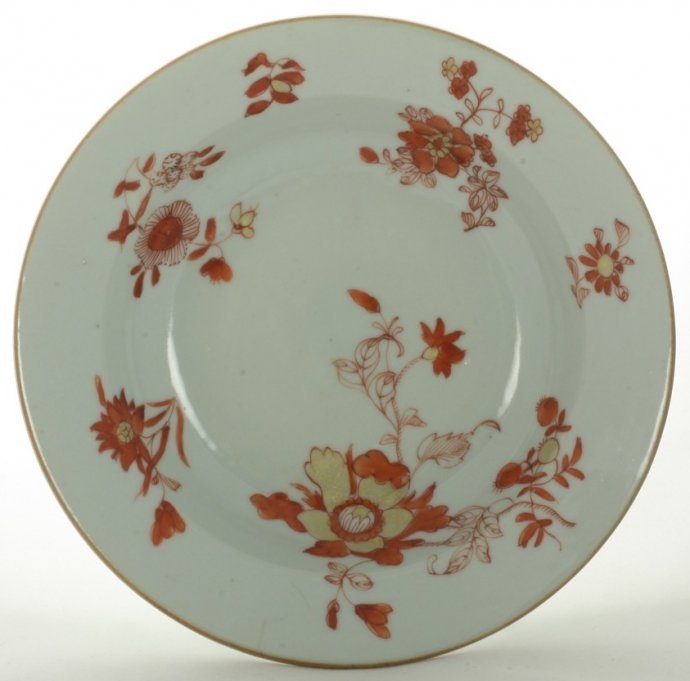
Sold Ceramics - Sold Red & Gold / Rouge-de-Fer 1690-1730 - Flowers, Animals and Long Elizas - Page 1
Object 2010422A
Cream dish
China
1740-1750
Height 23 mm (0.91 inch), diameter of rim 220 mm (8.66 inch), diameter of footring 110 mm (4.33 inch)
Cream dish on footring, flat underglaze brown-edged rim (jia mangkou). Decorated in 'Red & Gold' or 'Rouge de Fer' with iron-red, black enamel and gold on the glaze with an overall design of flowering peony in various stages of bloom. The reverse is undecorated.
Condition: A glaze hairline to the rim (only visible on the front).
References:
Price: Sold.


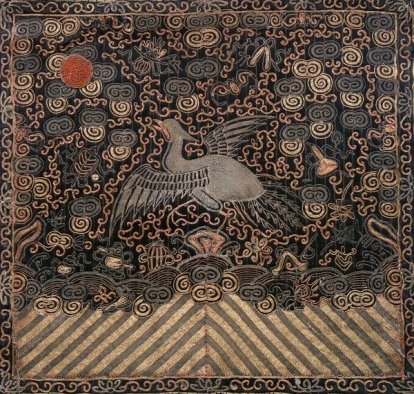
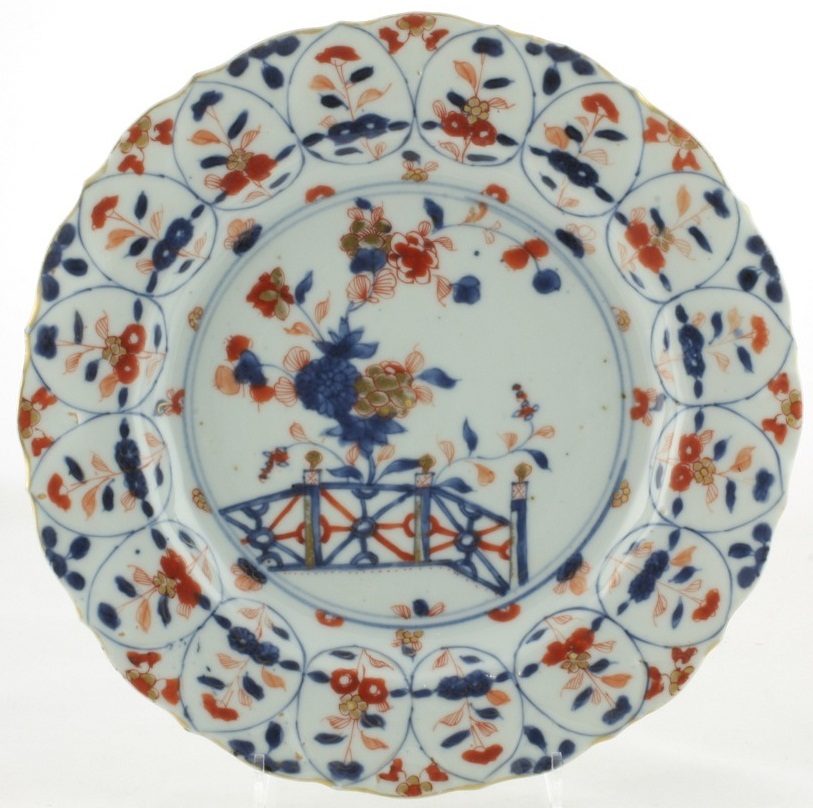
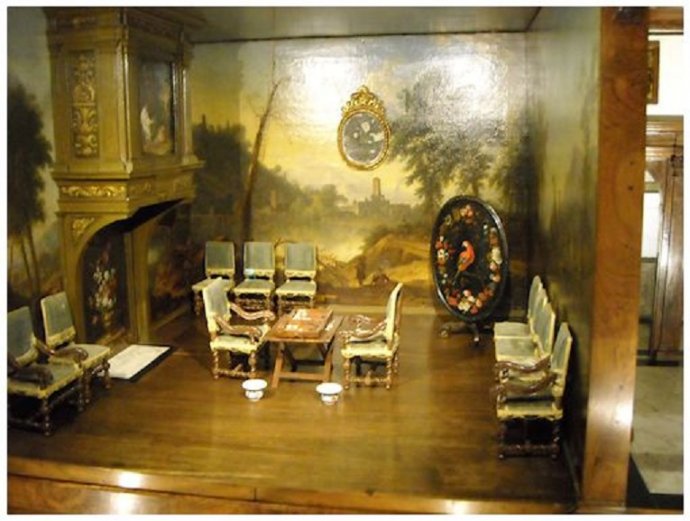
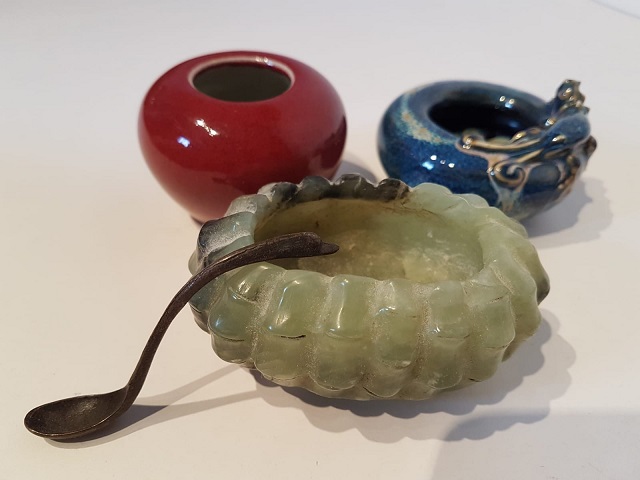
 create websites
create websites